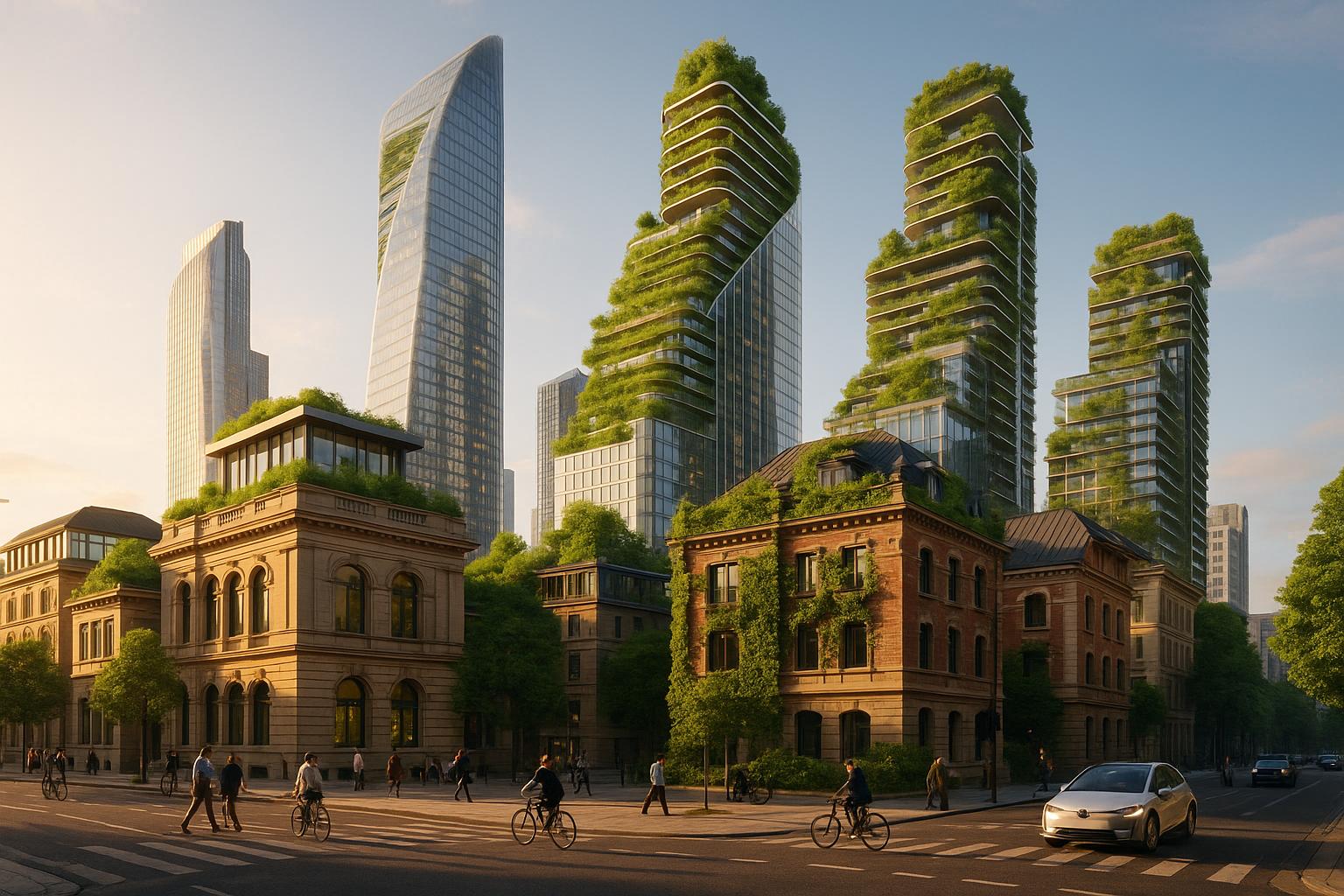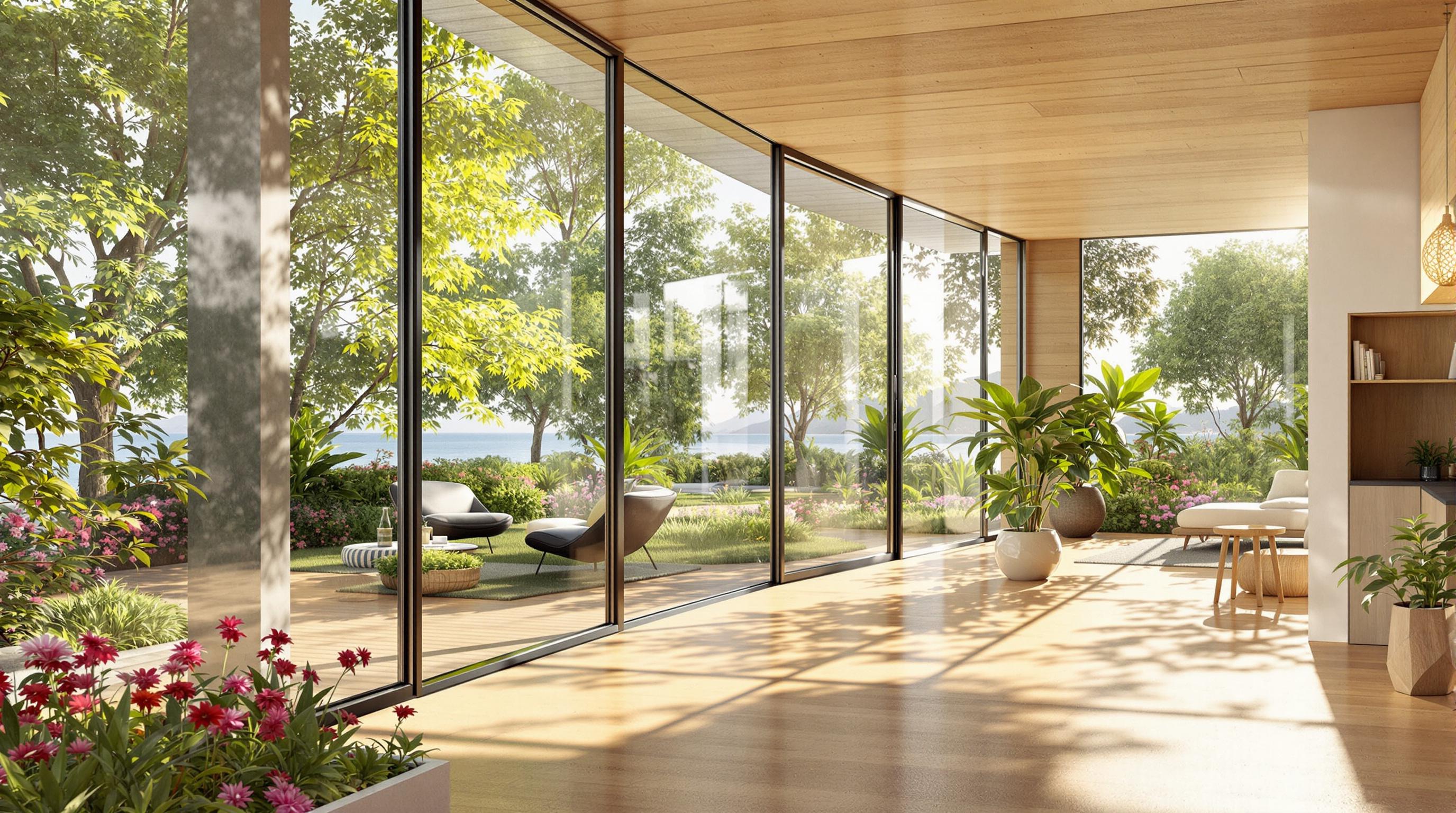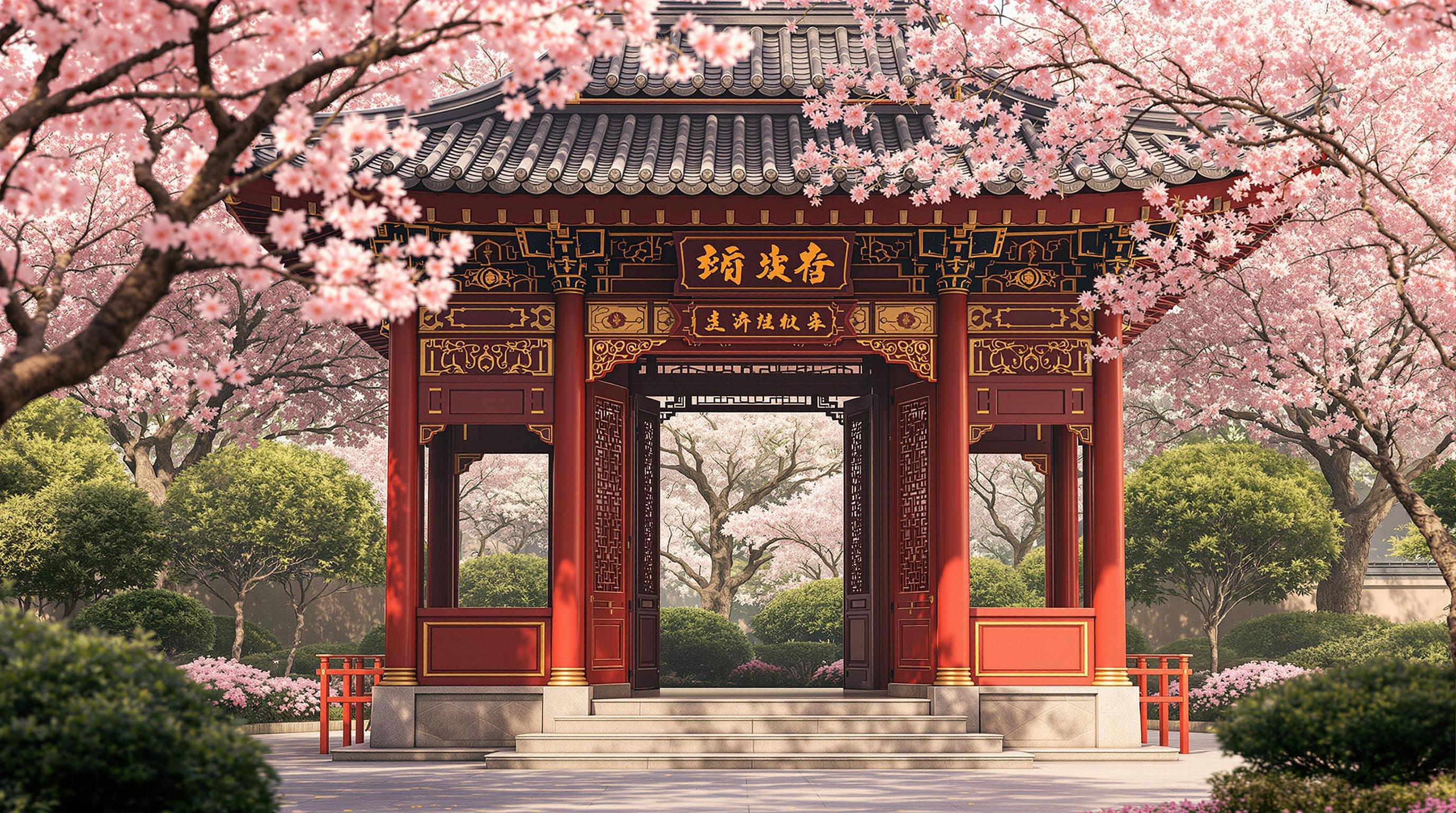: big living in small spaces
Tiny modernist homes are revolutionizing urban living. These compact dwellings (100-400 sq ft) blend minimalist design with smart functionality, offering:
- Affordability: $23,000-$70,000 vs $280,000 average US home
- Eco-friendly: Less energy use, sustainable materials
- Smart design: Multi-functional furniture, clever storage
- Open layouts: Maximizing space and light
Key features:
- Clean lines and geometric shapes
- Open floor plans
- Multi-functional elements (e.g. Murphy beds with desks)
- Large windows for natural light
- Clever storage solutions
- Quality materials (wood, concrete, glass)
- Indoor-outdoor flow
Popular tiny modernist designs:
- Urban micro apartments (200-370 sq ft)
- Compact modern cabins
- Minimalist studio homes
- Innovative small spaces (161-350 sq ft)
Space-saving tips:
- Use vertical storage
- Choose multi-functional furniture
- Implement hidden storage hacks
Efficient materials:
- Reclaimed wood
- Fiber cement siding
- Bamboo
- Mycelium (mushroom-based)
Tiny modernist living isn't just a trend - it's reshaping how we think about home, pushing us to live with less and focus on what matters.
Related video from YouTube
Essential Elements of Tiny Modernist Spaces
Tiny modernist spaces pack a punch with smart design. These compact homes blend minimalism and functionality in limited square footage. Let's dive into what makes these innovative living spaces tick.
Space Optimization: Making Every Inch Count
In tiny modernist homes, space is gold. Designers use clever tricks to squeeze the most out of every nook and cranny. Take multi-functional furniture, for example. A sofa-bed does double duty - comfy seating by day, cozy bed by night.
Loft sleeping areas are another space-saving gem. By going up instead of out, these elevated beds free up floor space for other uses. It's like having two rooms in one!
Form Follows Function: Design with Purpose
Tiny home design takes the "form follows function" principle to heart. Everything needs to earn its keep - no room for useless frills here. You'll see this in action in tiny home kitchens, where compact appliances and smart storage make cooking a breeze in a fraction of the space.
"The key is to prioritize efficiency, multipurpose solutions, and smart design choices." - Tiny Home Dealer
This quote nails it. Tiny modernist spaces are all about creating purposeful environments where every element pulls its weight.
Let There Be Light: Opening Up Space
Natural light is a tiny home's best friend. It turns small spaces into bright, airy havens. Big windows, skylights, and glass doors let the sunshine pour in and blur the lines between inside and out.
United Tiny Homes puts it well: "Maximizing natural light in your tiny home isn't just about making your space look bigger and brighter; it's a game-changer for your well-being and energy bills." It's not just about looks - it's about feeling good and saving energy too.
Keep It Simple: The Modernist Look
Tiny modernist spaces love clean lines and simplicity. This isn't just about style - it's practical too. By ditching fancy details and sticking to simple shapes, these homes feel more spacious and harmonious.
Quality Materials: Less is More
In tiny spaces, every material counts. Designers often go for top-notch, durable stuff that looks good and works hard. Wood, concrete, and glass are popular picks. They add warmth and realness while keeping things minimal.
Open Up: Enhancing Flow
Knock down those walls! Open floor plans are a tiny modernist staple. By getting rid of unnecessary dividers, these homes feel bigger than they are. Plus, light travels better, and the whole space just flows.
Smart Storage: Hide and Seek
Clever storage is the unsung hero of tiny living. Built-in cabinets, under-bed drawers, and hidden nooks are sneakily worked into the design. This way, you can keep your stuff without cluttering up your space. It's like magic - now you see it, now you don't!
Signature Elements of Tiny Modernist Spaces
Tiny modernist spaces are a lesson in efficient, stylish living. These compact homes pack a punch with their unique design elements that maximize both form and function. Let's dive into the key features that make these innovative living spaces stand out.
Clean Lines and Geometric Forms
Tiny modernist design is all about clean, uncluttered lines and simple geometric shapes. This look doesn't just look good - it makes spaces feel bigger. Take the Vesta-32 by California Tiny House. Its crisp edges and rectangular windows create a sense of order and openness, making the 32-foot space feel roomier than it is.
Open Floor Plans
Open layouts are a must in tiny modernist homes. By ditching unnecessary walls, these spaces flow smoothly from one area to another. The Halcyon, by Fritz Tiny Homes, nails this approach. Its open design creates a bright, welcoming vibe that makes you forget you're in a small space.
"The Halcyon shows the perfect blend of luxury and functionality in tiny house living", says the designer at Fritz Tiny Homes.
This open concept doesn't just make the space feel bigger - it also lets you use the limited square footage in more ways.
Multi-functional Features
In tiny modernist spaces, everything needs to pull its weight. Multi-use furniture and built-in features aren't just nice to have - they're essential. Think beds that fold into walls, tables that work for both dining and working, and stairs with hidden storage.
INDI'S by Raglan Tiny Homes takes this idea and runs with it. Their design packs in storage everywhere, making sure every inch of space works hard. This smart approach means you can have all the perks of a bigger home without the extra space.
Letting the Light In
Big windows, skylights, and glass doors are must-haves in tiny modernist design. These features flood the space with natural light, making it feel airy and open. The Vesta-32's smart window placement is a great example. It makes the space feel bigger and more connected to the outdoors, even though it's compact.
Clever Storage Solutions
Smart storage is the unsung hero of tiny modernist living. Built-in shelves, under-floor spaces, and hidden nooks are worked seamlessly into the design. This approach keeps clutter out of sight while keeping the clean, minimalist look that defines these spaces.
Quality Materials
In tiny homes, every surface is on show, so material choice matters. Tiny modernist spaces often use high-quality, tough materials that look good and last. Wood, concrete, and glass are popular choices. They add warmth and a real feel while keeping things simple.
Bringing the Outdoors In
Many tiny modernist designs blur the line between inside and outside. INDI'S by Raglan Tiny Homes does this well with its big French doors and folding walls. This design choice makes the living space feel bigger by turning the outdoors into an extension of the home.
Small Modernist Home Designs
Small modernist homes are changing how we think about urban living. They show that you can live well in a small space without sacrificing style or comfort.
Urban Micro Apartments
City centers are seeing a rise in micro apartments. In New York City, Carmel Place by nARCHITECTS is a standout example. It has 55 tiny units, each between 250 and 370 square feet. These apartments make the most of every inch with smart furniture like beds that fold up and tables that expand.
"Resident testimonials have emphasized the significance of multifunctional furniture in maintaining a clutter-free and liveable environment", notes nARCHITECTS.
In Tokyo, architect Yoshihiro Takishima has pushed the idea even further. His renovated building in Shibuya has apartments around 200 square feet. They feel bigger than they are, thanks to high ceilings with loft beds and big windows that let in lots of light.
Compact Modern Cabins
If you want to get away from the city, modern tiny cabins might be your thing. The "Love2 House" in Japan, designed by Takeshi Hosaka, is tiny but mighty. At just 204 square feet, it uses seven clever dividers to create different areas. Big skylights make it feel much larger than it is.
Over in Lithuania, IM Interior created a eye-catching steel cabin that's only 226 square feet. It has a bed that doubles as a window seat and a slim shelf that works as both a desk and dining table. It's a great example of how modern design can make a tiny space work well.
Minimalist Studio Homes
Studio apartments are getting a modern makeover. In Paris, someone turned a tiny 193-square-foot maid's room into a cool, minimalist space. It uses sunlight, bold colors, and interesting shapes to feel lively. Light oak shelves cleverly mark off the bedroom area, showing how smart design can make even the smallest spaces feel separate and useful.
Graham Hill, who's known for promoting small-space living, practices what he preaches in his 350-square-foot New York apartment. His space can quickly change from a living room to a bedroom. This flexibility is key in small modern designs, where every inch needs to work hard.
Innovative Design Solutions
What makes these small modern homes special is how they use space and materials in new ways. The "Shoe Box" apartment in Lebanon, designed by Eliemetni, fits everything into just 161 square feet. Custom furniture helps this tiny apartment work like a much bigger home.
In Glasgow, a 269-square-foot apartment designed by Lee Ivett, Simon Harlow, and Duncan Blackmore shows how built-in features can replace regular furniture. A fixed bench and a shelf that works as a desk mean you don't need separate pieces. They even put the bed above a small shower room to use the vertical space.
These small modern homes aren't just about saving space. They're about rethinking how we live. By using clever design, good materials, and a less-is-more approach, these tiny spaces show us a new way of living that's efficient, stylish, and fits the 21st century.
sbb-itb-1be9014
1. Space Optimization
In tiny modernist homes, every inch counts. Here's how to make the most of your compact space:
Vertical Storage Solutions
Think up, not out. Corner shelves are a tiny home hero. They don't hog floor space, they're cheap, and they're a breeze to install. As @paradisetinyhomes on Instagram puts it:
"Corner shelves are a staple when it comes to tiny home storage. They don't get in the way, they're affordable, and they're relatively quick and easy to install."
Want to go big? Try floor-to-ceiling shelving. It's not just storage - it can split up your space too. Remember: in a tiny home, walls are storage gold mines.
Multi-functional Furniture
Get furniture that works overtime. Check out Tru Form Tiny's custom home with an elevator bed. It lifts up to reveal a fold-down desk underneath. One space, two uses - genius!
Or grab a storage ottoman. It's a seat, a table, and a secret storage spot all rolled into one. Tyson Ness, the brains behind Studio Ness, says:
"When space is at a premium, look into furniture that can cleverly disguise storage space, any small bit matters."
Hidden Storage Hacks
Time to get sneaky with storage. Don't forget about your stairs. @paradisetinyhomes suggests:
"Consider converting a portion of your stairs into shelving. This minor change is both practical and beautiful."
For clothes, think seasons. Use compression bags to pack away off-season outfits under your bed or in high cabinets. Professional Property Management of Northern Virginia recommends this trick:
"You have more room to access what you truly need, here and now."
2. Multi-functional Design
Tiny modernist spaces demand smart solutions. Let's look at three ideas that pack a punch:
Murphy Beds with Built-in Desks
Want a bedroom that doubles as an office? Check out the Deluxe Desk Bed with Hutch from Wallbeds "n" More. It's got a built-in hutch for storage and a desk that folds away when you need to sleep. Perfect for studios or guest rooms, it's a space-saving superhero.
Expandable Dining Tables
The Euro Table Bed is a game-changer. By day, it's a sleek table for dining or work. By night, it unfolds into a comfy bed. It's like having two rooms in one!
Loft Systems
Think up, not out. Loft systems use vertical space to create sleeping areas above and living spaces below. As Expand Furniture puts it, "You can buy a loft system and add a loft area to any room in your home." It's like having a treehouse inside your apartment.
"Murphy beds are a great option for those who live in small spaces but still want to have a bed for guests." - Jessica Holden, Experienced Executive Assistant
These designs don't just save space - they make your home work harder for you. It's not about cramming everything in, it's about smart solutions that adapt to your needs.
3. Material Efficiency
Tiny modernist homes need smart material use. Here's how to make the most of every inch:
Reclaimed Wood
Old wood gets new life in tiny homes. The Architectural Salvage Warehouse of Detroit tears down buildings to find unique pieces. This wood isn't just good for the planet - it looks great too. Use it for floors or accent walls to add character.
Fiber Cement Siding
This stuff is tough and eco-friendly. Jill Kolling from James Hardie says:
"Fiber cement won't burn or add fuel to a fire, nor will it ignite when exposed to a direct flame."
It's perfect for tiny homes in all kinds of weather. You won't need to replace it often, either.
Bamboo
Bamboo is changing the game for tiny homes. It grows fast, it's stronger than concrete when squeezed, and it's super light. Use it for floors, walls, or even to hold up your home.
Mycelium
Believe it or not, fungi are the future of building. Mycelium bricks are made from waste and mushroom roots. They resist water, mold, and fire. They're light and keep your home warm (or cool). Perfect for tiny homes anywhere.
Conclusion
Tiny modernist living isn't just a trend - it's changing how we think about our homes. These small spaces pack a big punch, combining style and function in ways that make city living better.
But it's not just about looking good. Tiny homes are about living better while using less. As Jessica Holden, an Executive Assistant, puts it:
"Murphy beds are a great option for those who live in small spaces but still want to have a bed for guests."
This shows how tiny homes make the most of every inch without giving up comfort.
The money side is pretty impressive too. Get this: 68% of tiny homeowners don't have a mortgage. Compare that to only 29.3% of regular homeowners. And the price tag? Tiny homes usually cost between $19,000 and $50,000. That's way less than the $360,600 you'd pay for an average new home back in 2015.
But it's not just about saving cash. Tiny homes push you to live with less stuff and think more about what really matters. The folks at My Modern Home sum it up nicely:
"At My Modern Home, we believe that the investments you make in your home should not just work for you today, but should enrich your life every day."
That's what tiny modernist living is all about - quality over quantity, experiences over things.
Looking ahead, tiny homes are getting even cooler. Designers are coming up with wild ideas to make small spaces work better. They're using smart furniture and eco-friendly materials like bamboo and mushroom-based stuff.
The ideas behind tiny modernist design - making the most of space, using things for multiple purposes, and picking materials wisely - are starting to show up in bigger buildings too. Heather Mastrangeli, who runs Innovatus Design, says:
"Many of my clients want their investment to stand the rest of time, and weaving in timeless elements is a great way to achieve this."
This means tiny modernist homes aren't just a passing fad. They're built to look good and work well for years to come.


